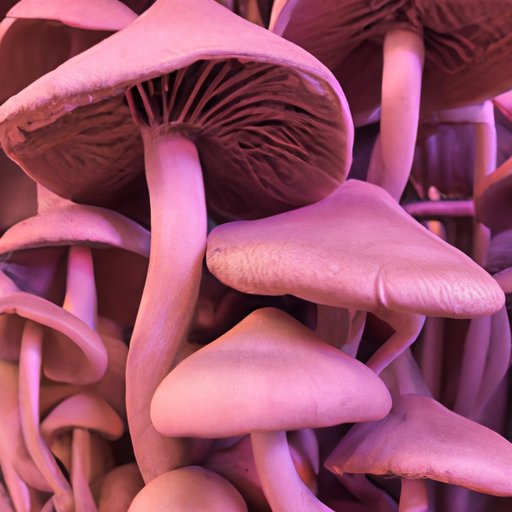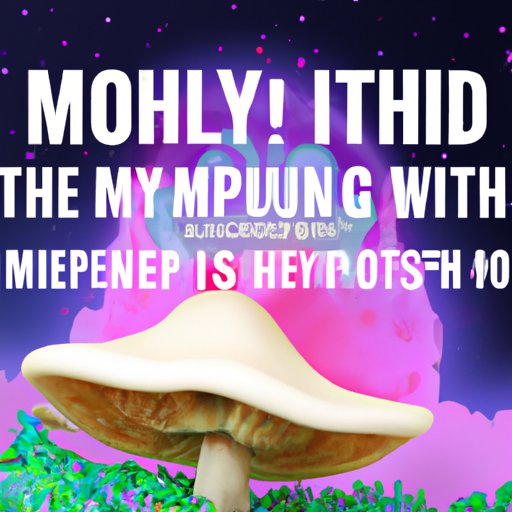
Introduction
Sleeping on shrooms is a relatively common phenomenon among shroom users, but it’s not without risks. While some people take shrooms to experience mind-bending trips or gain new insights, others find it difficult to stay awake or prefer to sleep after the peak effects have subsided. Regardless of your reasons, it’s essential to understand the do’s and don’ts of sleeping on shrooms to have a safe and enjoyable experience. In this article, we’ll provide a comprehensive guide on this topic for shroom users of all levels and backgrounds.
The Do’s and Don’ts of Sleeping on Shrooms: A Comprehensive Guide
Before you decide to sleep on shrooms, it’s crucial to consider the setting and environment in which you plan to do so. Ideally, you want to create a comfortable and relaxing atmosphere that allows you to rest without interruptions or distractions.
Some do’s and don’ts to keep in mind when sleeping on shrooms include:
- DO: Start with a low to moderate dose. High doses can make it difficult to fall asleep or trigger intense and unsettling dreams.
- DO: Prepare a comfortable sleeping spot with a soft mattress, pillows, and blankets. You may also want to use an eye mask or earplugs to reduce stimuli.
- DO: Avoid stimulants or other substances that may interfere with sleep, such as caffeine, nicotine, or alcohol.
- DO: Engage in relaxing activities before bedtime, such as meditation, deep breathing, or gentle yoga poses.
- DON’T: Sleep under the influence of shrooms if you have an underlying medical condition or take medication that may interact with psychedelics.
- DON’T: Sleep in an unsafe or unfamiliar environment that may trigger anxiety or paranoia.
- DON’T: Drive or operate heavy machinery after taking shrooms, especially if you haven’t had enough sleep or feel fatigued.

Debunking Myths: The Truth About Sleeping on Shrooms
One common myth about sleeping on shrooms is that it’s impossible or dangerous. While it’s true that shrooms can alter your perception of time and reality and affect your ability to fall asleep – especially at high doses – it’s not necessarily harmful or impossible.
Another myth is that sleeping on shrooms may lead to terrifying nightmares or flashbacks. While it’s true that shrooms can amplify your emotions and thoughts, making you more susceptible to bad dreams or anxiety, it doesn’t necessarily mean that you will experience them. In fact, many people report having lucid or vivid dreams under the influence of shrooms, which can be enlightening or therapeutic.
The Science Behind Sleep and Psychedelics: What You Need to Know
To understand how shrooms affect your sleep, it’s essential to know the basics of the sleep-wake cycle and how psychedelics interact with it.
During normal sleep, your brain goes through several stages, known as non-rapid eye movement (NREM) and rapid eye movement (REM) sleep. NREM sleep is divided into three stages, with the first stage being the lightest and the third stage the deepest. REM sleep, on the other hand, is characterized by rapid eye movements, high brain activity, and vivid dreaming.
Shrooms contain a chemical called psilocybin, which is converted into psilocin in the body and mimics the effects of serotonin, a neurotransmitter that regulates mood, appetite, and sleep. By binding to serotonin receptors in the brain, psilocin can modulate the activity of certain brain areas, such as the default mode network (DMN), which is responsible for self-referential and introspective thinking.
Studies have shown that psilocybin can alter the sleep-wake cycle by increasing the duration of NREM sleep and decreasing the amount of REM sleep. This can lead to less dreaming and more profound and restorative sleep, but can also affect your ability to wake up or stay alert for more extended periods.
How to Safely Navigate Sleep While Microdosing Shrooms
If you microdose shrooms and want to sleep, it’s essential to plan your timing and dosage carefully.
Microdosing refers to taking a sub-threshold or minimal dose of a psychedelic substance, such as shrooms, to enhance creativity, focus, or well-being without inducing a full-blown trip. Microdoses are usually around 0.1-0.5 grams of dried mushrooms, depending on body weight and tolerance.
To sleep safely while microdosing shrooms, you may want to:
- Time your dose early in the morning or midday to avoid interfering with your natural sleep rhythm.
- Avoid taking microdoses late in the evening or before bedtime, as they may increase your energy levels and make it harder to fall asleep.
- Prepare a welcoming and calming sleep environment, such as a dimly lit room with comfortable bedding and a sleep-friendly temperature.
- Avoid using electronic devices or engaging in stimulating activities before bedtime, as they may interfere with your natural melatonin secretion and disrupt your sleep quality.
A Personal Experience: Sleeping on Shrooms and What I Learned
As a shroom user, I have often experimented with sleeping on shrooms, and I have had both positive and negative experiences.
One time, after taking a moderate dose of shrooms in the evening, I fell asleep on my couch and soon started dreaming vividly about flying over a beautiful landscape. However, the dream quickly turned into a nightmare when I realized I couldn’t control my flight and started crashing into trees and cliffs, feeling agonizing pain and fear. I woke up sweating and felt a sense of relief that it was just a dream, but also a lingering feeling of unease and confusion.
To prevent similar experiences in the future, I have learned to be more mindful of my dose and timing, and to create a conducive sleep environment that promotes relaxation and comfort. I have also learned the value of introspection and self-reflection that shrooms can facilitate, but also the need to respect their power and potential risks.
Shroom Dreams: The Benefits and Risks of Sleeping on Magic Mushrooms
While sleeping on shrooms can have both benefits and risks, it’s up to each individual to decide whether it’s worth it or not.
Some potential benefits of sleeping on shrooms include:
- Enhanced emotional processing and regulation
- Increased creativity and insight
- Reduced anxiety and depression symptoms
- Deeper and more restful sleep
Some potential risks of sleeping on shrooms include:
- Prolonged insomnia or difficulty falling asleep
- Intense and unsettling dreams or nightmares
- Anxiety, paranoia, or hallucinations
- Disruptive effects on circadian rhythms and natural sleep architecture
To minimize these risks and maximize the benefits, it’s crucial to be responsible, informed, and attentive to your own needs and limits.
The Art of Sleeping on Shrooms: Tips and Tricks for a Restful Night
If you decide to sleep on shrooms, there are several tips and tricks you can use to enhance your rest and comfort.
Some of these tips include:
- Using a sleep mask or earplugs to reduce stimuli
- Playing calming ambient music or white noise
- Breathing deeply and slowly to induce relaxation
- Taking a warm bath or shower before bed
- Meditating or doing yoga to calm your mind and body
Conclusion
We hope this article has provided you with valuable insights and information about sleeping on shrooms. Whether you’re a seasoned user or a curious beginner, it’s crucial to approach these substances with respect, caution, and responsibility. While sleeping on shrooms can have both benefits and risks, it’s up to you to determine what works best for your individual needs and preferences.





